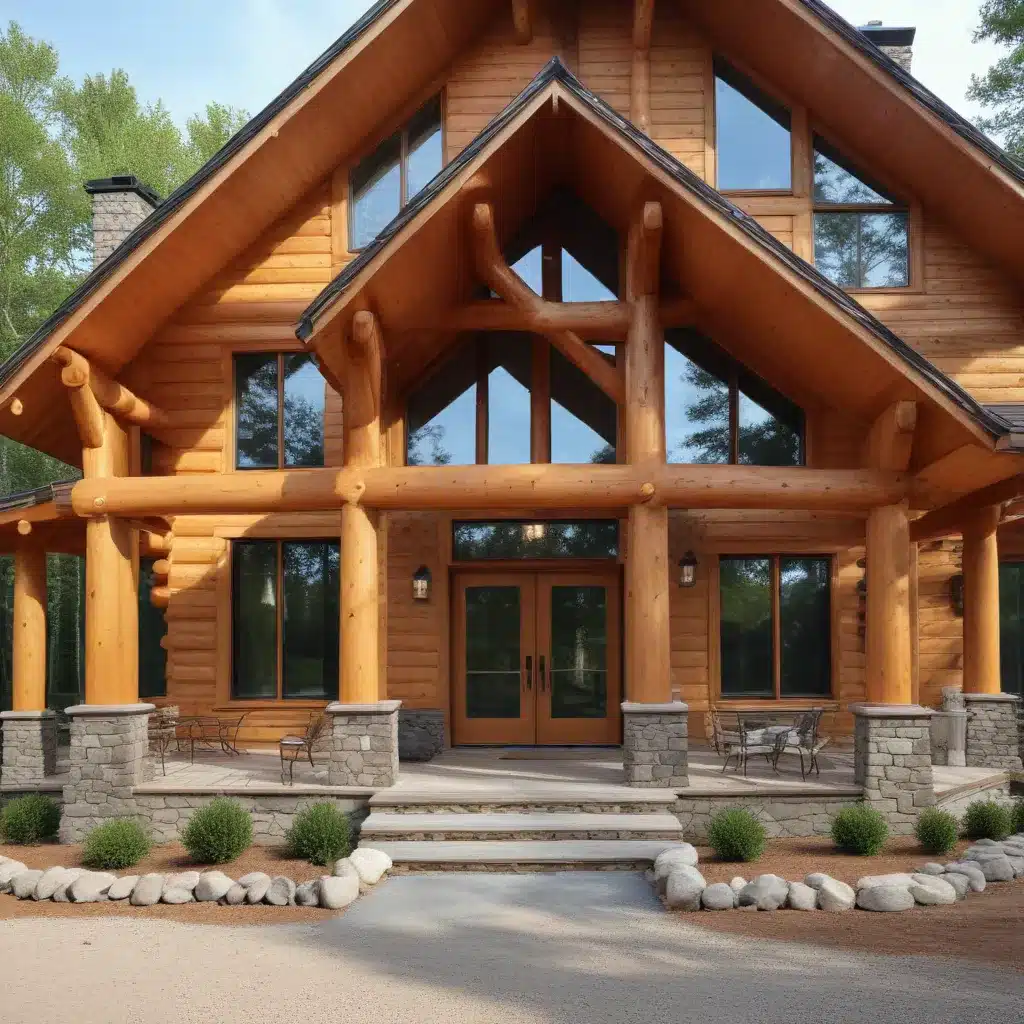
Embracing the Beauty and Craftsmanship of Timber Frame Construction
Log homes have long been a beloved part of the architectural landscape in the United States, offering a unique blend of rustic charm and modern comfort. As homeowners and builders alike seek to honor the rich heritage of this building style, there has been a growing trend towards incorporating regional architectural elements into contemporary log home designs.
Across the country, each geographic region boasts its own distinct architectural traditions, from the rugged mountain lodges of the West to the stately farmhouses of the Midwest. By carefully integrating these regional influences, log home designers can create structures that not only look stunning, but also seamlessly integrate with the surrounding natural environment.
Jorgensen Log Homes, a leading provider of custom log home solutions, has mastered the art of blending traditional craftsmanship with modern design principles. Their approach prioritizes the unique character and history of each building site, ensuring that every log home they create stands as a true reflection of the local architectural heritage.
Crafting Sustainable and Energy-Efficient Log Homes
One of the key advantages of log home construction is its inherent sustainability. Wood, the primary building material, is a renewable resource that can be harvested and processed with minimal environmental impact. Moreover, the thermal mass and insulating properties of log walls help to reduce energy consumption, making log homes a more energy-efficient choice compared to traditional frame construction.
Energy-Efficient Features of Log Homes:
| Feature | Benefit |
|---|---|
| Solid Log Walls | Provide excellent thermal mass, trapping heat in the winter and keeping homes cool in the summer. |
| Airtight Construction | Minimizes air leaks, reducing the need for heating and cooling. |
| High-Performance Windows | Maximize natural light while maintaining energy efficiency. |
| Efficient Heating and Cooling Systems | Utilize advanced technologies like geothermal or heat pump systems for optimal energy savings. |
| Sustainable Landscaping | Incorporate native plants and xeriscaping to reduce water usage. |
By incorporating these energy-efficient features, log home builders can create structures that not only look beautiful, but also prioritize environmental responsibility and long-term cost savings for homeowners.
Preserving Craftsmanship in Log Home Construction
The art of log home construction is deeply rooted in traditional building practices, with skilled craftsmen using time-honored techniques to create structures that stand the test of time. From the selection of the finest timber to the meticulous joinery and hand-finishing, every aspect of a log home’s construction reflects the dedication and expertise of the builders.
Key Craftsmanship Elements in Log Home Building:
- Timber Selection: Carefully choosing the right species of wood, such as Douglas fir, western red cedar, or Alaskan yellow cedar, to ensure durability and aesthetic appeal.
- Log Milling and Peeling: Employing specialized equipment and techniques to remove the bark and smooth the logs, creating a uniform and visually appealing surface.
- Interlocking Log Joints: Mastering the art of precision log notching and dovetailing to create sturdy, airtight connections between logs.
- Chinking and Sealing: Applying a traditional mixture of mortar, insulation, and sealants to fill the gaps between logs, providing additional thermal and structural integrity.
- Handcrafted Finishes: Incorporating hand-hewn or hand-scribed details, such as rustic beams, custom-carved doors, and unique architectural elements, to imbue the home with a one-of-a-kind character.
By preserving these time-honored craftsmanship techniques, log home builders are able to create structures that not only meet the highest standards of quality but also serve as enduring testaments to the rich heritage of this architectural style.
Customizing Log Homes to Suit Diverse Lifestyles
The beauty of log home construction lies in its inherent flexibility, allowing homeowners to tailor their dream homes to suit their unique needs and preferences. Whether it’s a cozy cabin nestled in the mountains or a sprawling estate surrounded by rolling hills, the adaptable floor plans and design elements of log homes can be seamlessly integrated to create the perfect living space.
Customization Opportunities in Log Home Design:
- Open Floor Plans: Maximize natural light and flow by incorporating large windows, vaulted ceilings, and open-concept layouts that blend indoor and outdoor living spaces.
- Personalized Finishes: Select from a variety of wood species, stains, and textures to create a custom aesthetic that reflects the homeowner’s personal style.
- Specialized Amenities: Incorporate features like home theaters, wine cellars, and dedicated hobby rooms to cater to the homeowner’s lifestyle and interests.
- Energy-Efficient Upgrades: Integrate high-performance insulation, smart home technology, and renewable energy systems to enhance the home’s sustainability and long-term cost savings.
By working closely with experienced log home builders, homeowners can seamlessly blend traditional craftsmanship with modern design elements, resulting in a residence that not only meets their practical needs but also serves as a true reflection of their unique vision.
Embracing the Future of Log Home Construction
As the demand for sustainable and regionally-inspired homes continues to grow, the future of log home construction in the United States is poised for an exciting evolution. Innovative building techniques, advanced materials, and a renewed appreciation for the timeless charm of timber frame architecture are all converging to shape the next generation of log homes.
Trends Shaping the Future of Log Home Design:
- Sustainable Material Sourcing: Increased emphasis on utilizing locally-sourced and responsibly-harvested timber, reducing the carbon footprint of log home construction.
- Modular and Prefabricated Systems: Advancements in prefabrication and off-site construction techniques that streamline the building process while maintaining quality and customization.
- Smart Home Integration: Integration of cutting-edge home automation and energy management systems to enhance the functionality and efficiency of log homes.
- Blending of Architectural Styles: Seamless incorporation of contemporary design elements, such as clean lines, large windows, and minimalist aesthetics, into traditional log home structures.
As homeowners and builders alike continue to embrace the enduring charm and environmental benefits of log home construction, the future of this architectural style promises to be an exciting and innovative one, honoring the past while embracing the possibilities of the future.


